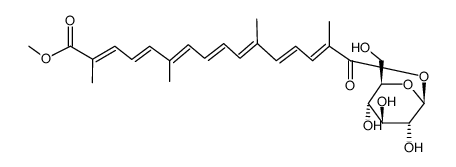55750-86-2
| Name | crocin-4 |
|---|---|
| Synonyms |
Crocin-Ψ
(2E,4E,6E,8E,10E,12E,14E)-2,6,11,15-Tetramethyl-hexadeca-2,4,6,8,10,12,14-heptaenedioic acid methyl ester (2S,3R,4S,5S,6R)-3,4,5-trihydroxy-6-hydroxymethyl-tetrahydro-pyran-2-yl ester |
| Description | Crocin-4, a carotenoid constituent of saffron, is a potent and brain-penetrant antioxidant agent. Crocin-4 can inhibit the aggregation and the concomitant deposition of Aβ fibrils in the brain. Crocin-4 can be used for the research of Alzheimer's Disease. Crocin-4 also exhibits antitumor and anti-inflammatory activities[1][2][3]. |
|---|---|
| Related Catalog | |
| In Vitro | Crocin-4 (0.1-1000 μM; 24-72 h) do not compromise cell viability of neuron-like cells[1]. Crocin-4 (1 mM; 72 h) reduces total PSEN1, PSEN1 and PSEN2 complexes, BACE1, APP-C99 and sAPPα, while it increases PSEN1-CTF and PSEN2 in SH-SY5Y-APP cells[1]. Crocin-4 (1 mM; 72 h) suppresses GSK3β and ERK1/2 kinases in PC12-htau cells, and significantly reduces the levels and phosphorylation of tau on the pThr231 and pSer199/Ser202 epitopes[1]. Western Blot Analysis[1] Cell Line: Differentiated SH-SY5Y-APP cells Concentration: 1 mM Incubation Time: 72 hours Result: Significantly reduced total PSEN1 by 19%, and the PSEN1 and PSEN2 complexes by 81 and 65%, while it increased PSEN1-CTF (26%) and PSEN2 (43%). The key molecules of the amyloidogenic pathway, BACE1 and APP-C99 were significantly reduced by 20 and 28%, respectively. The non-amyloidogenic pathway product sAPPα was also reduced, by 44%, while APP-C83 remained unaltered. Western Blot Analysis[1] Cell Line: Differentiated PC12-htau cells Concentration: 1 mM Incubation Time: 72 hours Result: Significantly reduced total tau levels (by 32%) and tau phosphorylation (pThr231 and pSer199/Ser202-tau by 22 and 75%, respectively). Downregulates the active and inactive forms of GSK3β (total GSK3β by 34%, pSer9-GSK3β by 30%) and ERK1/2 (total ERK2 by 37%, pERK1 by 40%, pERK2 by 50%). |
| In Vivo | Crocin-4 (50 mg/kg; i.p.) is capable of crossing the Blood Brain Barrier (BBB) and build up levels in the mouse brain[3]. |
| References |
| Molecular Formula | C27H36O9 |
|---|---|
| Molecular Weight | 504.56900 |
| Exact Mass | 504.23600 |
| PSA | 142.75000 |
| LogP | 1.95630 |
